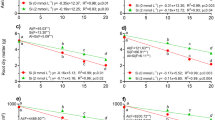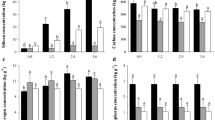Abstract
The purpose of this study is to evaluate the relationship between Si and NH4+ toxicity in the context of the nutrition, physiology, and production of sugar beet grown using hydroponics. We hypothesized that NH4+ affects the physiology of the plant, accumulation of nutrients, and dry matter, with the possibility for Si to mitigate this toxicity. The experimental design used was completely randomized, in a factorial scheme of 2 × 5, corresponding with the absence and presence of Si (2 mmol L−1) and five concentrations of NH4+ with four replicates. The following series of physiological evaluations were carried out: photosynthesis, stomatal conductance, transpiration, with the use of an infrared gas analyzer (LICOR, Inc., LI-6400), the dry biomass, N and Si accumulation, and Si use efficiency in the roots. Accumulation of N and photosynthesis in the leaves was higher in the presence of Si. An increase of NH4+ increased transpiration, especially in the plants cultivated without the incorporation of Si. Stomatal conductance was lower in the presence of Si. Dry matter was reduced when plants were exposed to higher concentrations of NH4+, showing a greater reduction in the root than in the aerial part. The use of NH4+ equal to or higher than 15 mmol L−1 damaged the photosynthesis. Transpiration and stomatal conductance were less affected in the presence of Si and in the accumulation of N and Si in the roots. Dry matter was reduced when plants were exposed to higher concentrations of NH4+, and this effect was mitigated in the presence of Si.



Similar content being viewed by others
References
Adrees M, Ali S, Rizwan M, Rehman MZ, Ibrahim M, Abbas F, Farid M, Qayyum MK, Irshad MK (2015) Mechanisms of silicon-mediated alleviation of heavy metal toxicity in plants: a review. Ecotoxicol Environ Saf 119:186–197
Bakhat HF, Bibi N, Zia Z, Abbas S, Hammad HM, Fahad S, Ashraf MR, Shah GM, Rabbani F, Saeed S (2018) Silicon mitigates biotic stresses in crop plants: a review. Crop Prot 104:21–34
Barbosa JC, Maldonado JRW (2014) AgroEstat - system for statistical analysis of agronomic trials - Version 1.1.0.711. Faculty of Agrarian and Veterinary Sciences, Sao Paulo State University, Jaboticabal
Barreto RF, Júnior AS, Maggio MA, de Mello Prado R (2017) Silicon alleviates ammonium toxicity in cauliflower and in broccoli. Sci Hortic 225:743–750
Barreto RF, Prado RM, Leal AJF, Troleis MJB, Junior GS, Monteiro CC, Carvalho RF (2016) Mitigation of ammonium toxicity by silicon in tomato depends on the ammonium concentration. Acta Agric Scand Sect B Soil Plant Sci 66:483–488
Bataglia OC, Furlani AMC, Teixeira JPF, Furlani PR, Gallo JR (1983) Métodos de análise química de plantas. Campinas, Instituto Agronômico. 48p. Boletim técnico, 78
Campos CNS, de Mello Prado R, Caione G, de Lima Neto AJ, Mingotte FLC (2016) Silicon and excess ammonium and nitrate in cucumber plants. Afr J Agric Res 11:276–283
Cooke J, Leishman MR (2016) Consistent alleviation of abiotic stress with silicon addition: a meta-analysis. Funct Ecol 30:1340–1357
Bittsánszky A, Pilinszk K, Gyulai G, Komives T (2015) Overcoming ammonium toxicity. Plant Sci 231:184–190
Bybordi A (2010) Influence of NO3:NH4 ratios and silicon on growth, nitrate reductase activity and fatty acid composition of canola under saline conditions. Afr J Agric Res 5:1984–1992
Campos CNS (2013) Silício e excesso de amônio e de nitrato em plantas de cana-de açúcar e de pepino. Thesis de maestrado, Universidad Estadual Paulista, UNESP, Jaboticabal, Sao Paulo, Brasil, 60 p
Camargo MS, Bezerra BLK, Vitti AC, Silva MA, Oliveira AL (2017) Silicon fertilization reduces the deleterious effects of water deficit in sugarcane. J Soil Sci Plant Nutr 17:99–111
Cruz C, Domínguez-Valdivia MD, Aparicio-Tejo PM, Lamsfus C, Bio A, Martins-Loução MA, Moran JF (2011) Intra-specific variation in pea responses to ammonium nutrition leads to different degrees of tolerance. Environ Exp Bot 70:233–243
Din M, Qasim M, Alam M (2007) Effect of different levels of N, P and K on the growth and yield of cabbage. J Agric Res 45:171–176
Epstein E (1994) The anomaly of silicon in plant biology. Proc Natl Acad Sci 91:11–17
Fageria NK, Baligar VC (2005) Enhancing nitrogen use efficiency in crop plants. Adv Agron 88:97–185
Ferreira Barreto R, Rodrigues Cruz FJ, Aparecido Gaion L, de Mello Prado R, Falleiros Carvalho R (2018) Accompanying ions of ammonium sources and nitrate: ammonium ratios in tomato plants. J Plant Nutr Soil Sci 181:382–387
Feng J, Shi Q, Wang X, Wei M, Yang F, Xu H (2010) Silicon supplementation ameliorated the inhibition of photosynthesis and nitrate metabolism by cadmium (Cd) toxicity in Cucumis sativus L. Sci Hortic 123:521–530
Filgueira FAR (2000) Novo manual de Olericultura: Agrotecnologia moderna na produção e comercialização de hortaliças. Viçosa: UFV. MG: Editora UFV
Frew A, Weston LA, Reynolds OL, Gurr GM (2018) The role of silicon in plant biology: a paradigm shift in research approaches. Ann Bot 121:1265–1273
Gao Q, Wang Y, Lu X (2014) Effects of exogenous silicon on physiological characteristics of cucumber seedlings under ammonium stress. J Appl Ecol 25:1395–1400
Guimarães MMC, Cairo PAR, Neves OSC (2014) Crescimento de Eucalyptus urophylla em meio hidropônico com diferentes proporções de nitrato e amônio. Floresta Ambient 21:52–61
Guntzer F, Keller C, Meunier JD (2012) Benefits of plant silicon for crops: a review. Agron Sustain Dev 32:201–213
Hachiya T, Watanabe CK, Fujimoto M, Ishikawa T, Takahara K, Kawai-Yamada M, Noguchi K (2012) Nitrate addition alleviates ammonium toxicity without lessening ammonium accumulation, organic acid depletion and inorganic cation depletion in Arabidopsis thaliana shoots. Plant Cell Physiol 53:577–591
Hirel B, Le Gouis J, Ney B, Gallais A (2007) The challenge of improving nitrogen use efficiency in crop plants: towards a more central role for genetic variability and quantitative genetics within integrated approaches. J Exp Bot 58:2369–2387
Hoagland DR, Arnon DI (1950) The water-culture method for growing plants without soil. In: Circular. California Agricultural Experiment Station, Vol 347. pp. 22–32
Horchani F, Hajri R, Aschi-Smiti S (2011) Is the sensitivity to ammonium nutrition related to nitrogen accumulation? Curr Bot 2:18–22
Huang L, Lu Y, Gao X, Du G, Ma X, Liu M, Chen Y (2013) Ammonium-induced oxidative stress on plant growth and antioxidative response of duckweed (Lemna minor L.). Ecol Eng 58:355–362
Iqbal MA, Saleem AM (2015) Sugar beet potential to beat sugarcane as a sugar crop in Pakistan. Am Eurasian J Agric Environ Sci 15:36–44
Ishikawa S, Ando S, Sakaigaichi T, Terajima Y, Matsuoka M (2009) Effects of high nitrogen application on the dry matter yield, nitrogen content and nitrate-N concentration of sugarcane. Soil Sci Plant Nutr 55:485–495
IPNI (2015) Silicon. Nutri-facts, No 14. http://www.ipni.net/publication/nutrifacts na.nsf/0/A7B4AB4D35C153BF85257ECE006E0E34/$FILE/NutriFacts-NA-14.pdf. Accessed 27 February 2019
Kochanová Z, Jašková K, Sedláková B, Luxová M (2014) Silicon improves salinity tolerance and affects ammonia assimilation in maize roots. Biologia 69:1164–1171
Kraska JE, Breitenbeck GA (2010) Simple, robust method for quantifying silicon in plant tissue. Commun Soil Sci Plant Anal 41:2075–2085
Liang Y, Nikolic M, Bélanger R, Gong H, Song A (2015) Silicon in agriculture. Springer, Dordrecht
Liang Y, Sun W, Zhu YG, Christie P (2007) Mechanisms of silicon-mediated alleviation of abiotic stresses in higher plants: a review. Environ Pollut 147:422–428
Liu H, Wang QQ, Yu MM, Zhang YY, Wu YB, Zhang HX (2008) Transgenic salt-tolerant sugar beet (Beta vulgaris L.) constitutively expressing an Arabidopsis thaliana vacuolar Na+/H+ antiporter gene, AtNHX3, accumulates more soluble sugar but less salt in storage roots. Plant Cell Environ 31:1325–1334
Liu JJ, Lin SH, Xu PL, Wang XJ, Bai JG (2009) Effects of exogenous silicon on the activities of antioxidant enzymes and lipid peroxidation in chilling-stressed cucumber leaves. Agric Sci China 8:1075–1086
Mateos-Naranjo E, Andrades-Moreno L, Davy AJ (2013) Silicon alleviates deleterious effects of high salinity on the halophytic grass Spartina densiflora. Plant Physiol Biochem 63:115–121
Nasraoui-Hajaji A, Gouia H (2014) Photosynthesis sensitivity to NH4 +-N change with nitrogen fertilizer type. Plant Soil Environ 60:274–279
Olivera VD, de Mello Prado R, Lizcano Toledo R, Nascimento dos Santos LC, Peña Calzada K (2017) Response of radish seedlings (Raphanus sativus L.) to different concentrations of ammoniacal nitrogen in absence and presence of silicon. Agron Colomb 35:198–204
Oliveira AP, Moura MF, Nogueira DH, Chagas NG, Braz MSS, Oliveira MRT, Barbosa JA (2006) Produção de raízes de batata-doce em função do uso de doses de N aplicadas no solo e via foliar. Hortic Bras 24:279–282
Prado RM (2008) Nitrogênio. In: Nutrição de plantas. Jaboticabal: Editora UNESP, cap. 4:83–120
Resende GM, Cordeiro GG (2007) Uso da água salina e condicionador de solo na produtividade de beterraba e cenoura no semi-árido do Submédio São Francisco. Embrapa Semiárido-Comunicado Técnico (INFOTECA-E). 4p. Comunicado Técnico 128
Sandhya K, Prakash NB, Meunier JD (2018) Diatomaceous earth as source of silicon on the growth and yield of rice in contrasted soils of southern India. J Soil Sci Plant Nutr 18:344–360
Sarasketa A, González-Moro MB, González-Murua C, Marino D (2014) Exploring ammonium tolerance in a large panel of Arabidopsis thaliana natural accessions. J Exp Bot 65:6023–6033
Song AL, Li P, Li ZJ, Fan FL, Liang YC (2014) The effect of silicon on photosynthesis and expression of its relevant genes in rice (Oryza sativa L.) under high-zinc stress. PLoS One 9:e113782
Souza RD, Fontanetti A, Fiorini CVA, Almeida KD (2003) Cultura da beterraba: Cultivo convencional e cultivo orgânico. UFLA, Lavras 37p
Shaw B, Thomas TH, Cooke DT (2002) Responses of sugar beet (Beta vulgaris L.) to drought and nutrient deficiency stress. Plant Growth Regul 37:77–83
Vaculíková M, Vaculík M, Šimková L, Fialová I, Kochanová Z, Sedláková B, Luxová M (2014) Influence of silicon on maize roots exposed to antimony—growth and antioxidative response. Plant Physiol Biochem 83:279–284
Zanin L, Zamboni A, Monte R, Tomasi N, Varanini Z, Cesco S, Pinton R (2015) Transcriptomic analysis highlights reciprocal interactions of urea and nitrate for nitrogen acquisition by maize roots. Plant Cell Physiol 56:532–548
Acknowledgements
The present work was conducted with the support from CNPq, Brazilian National Council for Scientific and Technological Development – Brazil, and TWAS, the Academy of Sciences for the Developing World.
Funding
This study was funded by CNPq, Brazilian National Council for Scientific and Technological Development – Brazil, and TWAS, the Academy of Sciences for the Developing World (Grant number, 304201/2014-6).
Author information
Authors and Affiliations
Corresponding author
Ethics declarations
Competing Interests
The authors declared that they have no competing interests.
Additional information
Publisher’s Note
Springer Nature remains neutral with regard to jurisdictional claims in published maps and institutional affiliations.
Highlights
The negative effects caused by the toxicity of NH4+ in sugar beet plants, up to concentrations of 15 mmol L−1, can be mitigated by the presence of Si.
Plant physiology is compromised at high concentrations of NH4+.
At 15 mmol L−1 of NH4+, the dry matter in the roots is reduced even though Si is present.
Rights and permissions
About this article
Cite this article
Viciedo, D.O., de Mello Prado, R., Lizcano Toledo, R. et al. Silicon Supplementation Alleviates Ammonium Toxicity in Sugar Beet (Beta vulgaris L.). J Soil Sci Plant Nutr 19, 413–419 (2019). https://doi.org/10.1007/s42729-019-00043-w
Received:
Accepted:
Published:
Issue Date:
DOI: https://doi.org/10.1007/s42729-019-00043-w




